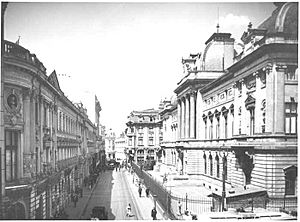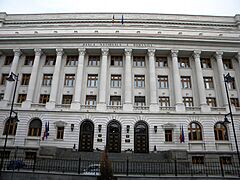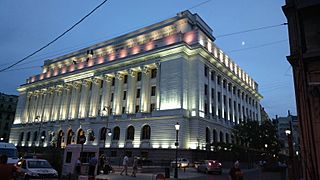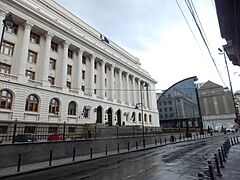National Bank of Romania facts for kids
 |
|

National Bank of Romania headquarters in Bucharest
|
|
| Headquarters | Bucharest |
|---|---|
| Established | April 1880 |
| Ownership | 100% state ownership |
| Governor | Mugur Isărescu |
| Central bank of | Romania |
| Currency | Romanian leu RON (ISO 4217) |
| Reserves | |
| Bank rate | 6.50 |
| Website | www.bnro.ro |
The National Bank of Romania (Romanian: Banca Națională a României, BNR) is the central bank of Romania. It was started in April 1880. Its main office is in Bucharest, the capital city.
The National Bank of Romania is in charge of printing and managing the Romanian leu, which is Romania's money. It also helps set the country's money rules, keeps its money safe, and manages how much the leu is worth compared to other currencies.
Contents
History of the National Bank
The first leader of the bank was Ion Câmpineanu. Another important person was Eugeniu Carada. He helped create the bank and was chosen as a director. However, he never became the Governor.
Valuables Sent Away (1916)
In 1916, during World War I, Romania faced an invasion. To keep its valuable items safe, the National Bank of Romania sent many of them to Moscow. This collection of items is known as the Romanian Treasure.
Most of these valuables were never returned to Romania. However, some items did come back. These included the Pietroasele treasure, which you can now see at the National Museum of Romanian History. Some old coins, paintings, and important papers also returned.
Recent Cooperation (2021)
On June 11, 2021, the current Governor, Mugur Isărescu, met with Octavian Armașu. He is the governor of the National Bank of Moldova. They agreed to work together more closely.
This agreement helps both banks improve how they work. It covers things like managing money, checking on banks, and handling financial problems. They also agreed to work on digital money and payment systems.
Architecture of the BNR Buildings
The National Bank of Romania has two main buildings. Both are impressive and show different styles of architecture.
The Old BNR Palace
The older building of the National Bank of Romania is on Lipscani Street. It is a very grand and large bank building. Today, it is seen as an important historical and art monument. It was built where an old inn used to be.
Two architects, Cassien Bernard and Albert Galleron, designed the building. Construction started on July 12, 1884. It finished in June 1890. The building has a mix of styles from the late 1800s, with some classic elements.
The New BNR Palace
The newer part of the BNR Palace faces Doamnei Street. Its construction began in 1937. It was built during World War II, between 1942 and 1944.
Architect Ion Davidescu led the building project. Two other architects, Radu Dudescu and N. Crețoiu, helped him. This building shows a style popular between the two World Wars. It has large granite stairs and huge Corinthian columns on its front. Inside, there are big halls covered in white marble.
What the National Bank Does
The National Bank of Romania has several important jobs:
- It decides and carries out the country's money rules. This includes rules about how much the Romanian leu is worth.
- It checks on banks and makes sure they are working well. This helps keep the financial system stable and safe.
- It prints and puts out banknotes and coins. These are the official money used in Romania.
- It sets the rules for how money can be exchanged. It also makes sure these rules are followed.
- It manages Romania's official money reserves. These are like the country's savings.
Gallery
- National Bank of Romania
See also
 In Spanish: Banco Nacional de Rumania para niños
In Spanish: Banco Nacional de Rumania para niños
- Economy of Romania
- Romanian leu
- List of central banks








